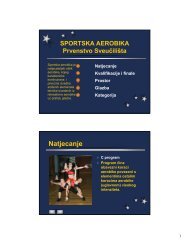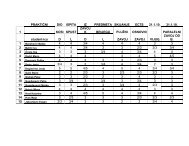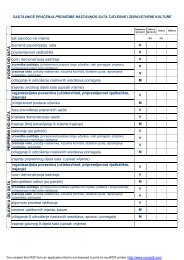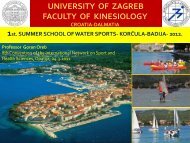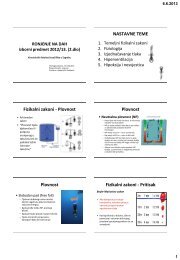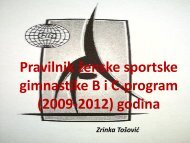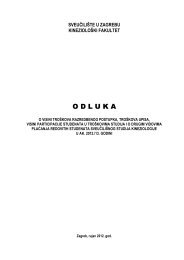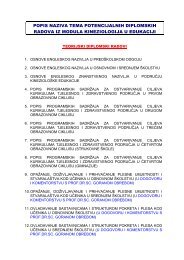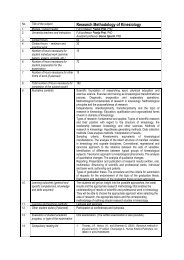The Journal of P hysiology Physiological adaptations to low-volume ...
The Journal of P hysiology Physiological adaptations to low-volume ...
The Journal of P hysiology Physiological adaptations to low-volume ...
Create successful ePaper yourself
Turn your PDF publications into a flip-book with our unique Google optimized e-Paper software.
J Physiol 590.5 (2012) pp 1077–1084 1077<br />
<strong>Physiological</strong> <strong>adaptations</strong> <strong>to</strong> <strong>low</strong>-<strong>volume</strong>, high-intensity<br />
interval training in health and disease<br />
Martin J. Gibala 1 , Jonathan P. Little 2 , Maureen J. MacDonald 1 and John A. Hawley 3<br />
1<br />
Department <strong>of</strong> Kinesiology, McMaster University, Hamil<strong>to</strong>n, Ontario L8S 4K1, Canada<br />
2<br />
School <strong>of</strong> Arts and Sciences, University <strong>of</strong> British Columbia Okanagan, Ke<strong>low</strong>na, British Columbia V1V 1V7, Canada<br />
3<br />
Exercise Metabolism Group, RMIT University, Bundoora, Vic<strong>to</strong>ria 3083, Australia<br />
<strong>The</strong> <strong>Journal</strong> <strong>of</strong> P<strong>hysiology</strong><br />
Abstract Exercise training is a clinically proven, cost-effective, primary intervention that delays<br />
and in many cases prevents the health burdens associated with many chronic diseases. However,<br />
the precise type and dose <strong>of</strong> exercise needed <strong>to</strong> accrue health benefits is a contentious issue<br />
with no clear consensus recommendations for the prevention <strong>of</strong> inactivity-related disorders and<br />
chronic diseases. A growing body <strong>of</strong> evidence demonstrates that high-intensity interval training<br />
(HIT) can serve as an effective alternate <strong>to</strong> traditional endurance-based training, inducing similar<br />
or even superior physiological <strong>adaptations</strong> in healthy individuals and diseased populations, at<br />
least when compared on a matched-work basis. While less well studied, <strong>low</strong>-<strong>volume</strong> HIT can<br />
also stimulate physiological remodelling comparable <strong>to</strong> moderate-intensity continuous training<br />
despite a substantially <strong>low</strong>er time commitment and reduced <strong>to</strong>tal exercise <strong>volume</strong>. Such findings<br />
are important given that ‘lack <strong>of</strong> time’ remains the most commonly cited barrier <strong>to</strong> regular exercise<br />
participation. Here we review some <strong>of</strong> the mechanisms responsible for improved skeletal muscle<br />
metabolic control and changes in cardiovascular function in response <strong>to</strong> <strong>low</strong>-<strong>volume</strong> HIT. We<br />
also consider the limited evidence regarding the potential application <strong>of</strong> HIT <strong>to</strong> people with, or<br />
at risk for, cardiometabolic disorders including type 2 diabetes. Finally, we provide insight on the<br />
utility <strong>of</strong> <strong>low</strong>-<strong>volume</strong> HIT for improving performance in athletes and highlight suggestions for<br />
future research.<br />
(Received 16 November 2011; accepted after revision 23 January 2012; first published online 30 January 2012)<br />
Correspondingauthor M. J. Gibala: Department <strong>of</strong> Kinesiology, McMaster University, 1280 Main Street West, Hamil<strong>to</strong>n,<br />
Ontario, L8S 4K1 Canada. Email: gibalam@mcmaster.ca<br />
Abbreviations HIT, high-intensity interval training; PGC-1α, peroxisome-prolifera<strong>to</strong>r activated recep<strong>to</strong>r γ coactiva<strong>to</strong>r;<br />
PPO, peak aerobic power output.<br />
Introduction<br />
High-intensity interval training (HIT) describes physical<br />
exercise that is characterized by brief, intermittent bursts<br />
<strong>of</strong> vigorous activity, interspersed by periods <strong>of</strong> rest or<br />
<strong>low</strong>-intensity exercise. HIT is infinitely variable with the<br />
specific physiological <strong>adaptations</strong> induced by this form <strong>of</strong><br />
Martin Gibala (pictured) is Pr<strong>of</strong>essor and Chair <strong>of</strong> the Department <strong>of</strong> Kinesiology at McMaster University. He studies the<br />
regulation <strong>of</strong> skeletal muscle energy metabolism including the impact <strong>of</strong> nutrition and training on exercise performance.<br />
Maureen MacDonald is also a Pr<strong>of</strong>essor <strong>of</strong> Kinesiology at McMaster, where she studies the effect <strong>of</strong> exercise on cardiovascular<br />
regulation. Jonathan Little completed doc<strong>to</strong>ral studies at McMaster and is currently a postdoc<strong>to</strong>ral fel<strong>low</strong> at the University<br />
<strong>of</strong> British Columbia. John Hawley is Pr<strong>of</strong>essor and Head <strong>of</strong> the Exercise Metabolism Group at RMIT University, whose focus<br />
is skeletal muscle energy metabolism related <strong>to</strong> exercise and diabetes.<br />
This review is from the symposium Exercise metabolism at <strong>The</strong> Biomedical Basis <strong>of</strong> Elite Performance, a joint meeting <strong>of</strong> <strong>The</strong> <strong>Physiological</strong> Society<br />
and the British Pharmacological Society, <strong>to</strong>gether with <strong>The</strong> <strong>Journal</strong> <strong>of</strong> P<strong>hysiology</strong>, Experimental P<strong>hysiology</strong>, British <strong>Journal</strong> <strong>of</strong> Pharmacology and <strong>The</strong><br />
Scandinavian <strong>Journal</strong> <strong>of</strong> Medicine and Science in Sports, at the Queen Elizabeth Hall, London on 20 March 2012.<br />
C○ 2012 <strong>The</strong> Authors. <strong>The</strong> <strong>Journal</strong> P<strong>hysiology</strong> C○ 2012 <strong>The</strong> <strong>Physiological</strong> Society<br />
Downloaded from J Physiol (jp.physoc.org) by guest on March 21, 2012<br />
DOI: 10.1113/jphysiol.2011.224725
1078 M. J. Gibala and others J Physiol 590.5<br />
Table 1. Summary <strong>of</strong> pro<strong>to</strong>cols in studies from our labora<strong>to</strong>ry that directly compared 6 weeks <strong>of</strong> either high-intensity interval training<br />
(HIT) or traditional endurance training<br />
Variable HIT group Endurance group<br />
Pro<strong>to</strong>col 30 s × 4–6 repeats, 4.5 min rest (3 sessions per week) 40–60 min cycling (5 sessions per week)<br />
Training intensity (workload) ‘All out’ maximal effort (∼500 W) 65% <strong>of</strong> ˙V O2 peak (∼150 W)<br />
Weekly training time commitment ∼10 min (∼1.5 h including rest) ∼4.5 h<br />
Weekly training <strong>volume</strong> ∼225 kJ ∼2250 kJ<br />
From Burgomaster et al. (2008). ˙V O2 peak, peak oxygen uptake.<br />
training determined by a myriad <strong>of</strong> fac<strong>to</strong>rs including the<br />
precise nature <strong>of</strong> the exercise stimulus (i.e. the intensity,<br />
duration and number <strong>of</strong> intervals performed, as well<br />
as the duration and activity patterns during recovery).<br />
When compared on a matched-work basis or when<br />
estimated energy expenditure is equivalent, HIT can serve<br />
as an effective alternate <strong>to</strong> traditional endurance training,<br />
inducing similar or even superior changes in a range <strong>of</strong><br />
physiological, performance and health-related markers<br />
in both healthy individuals and diseased populations<br />
(Wisl<strong>of</strong>f et al. 2007; Tjonna et al. 2009; Hwang et al.<br />
2011). Less is known regarding the effects <strong>of</strong> <strong>low</strong>-<strong>volume</strong><br />
HIT, but growing evidence suggests this type <strong>of</strong> training<br />
stimulates physiological remodelling comparable with<br />
moderate-intensity continuous training despite a substantially<br />
<strong>low</strong>er time commitment and reduced <strong>to</strong>tal<br />
exercise <strong>volume</strong> (Gibala & McGee 2008). <strong>The</strong>se findings<br />
are important from a public health perspective, given<br />
that ‘lack <strong>of</strong> time’ remains one <strong>of</strong> the most commonly<br />
cited barriers <strong>to</strong> regular exercise participation (Stutts<br />
2002; Trost et al. 2002; Kimm et al. 2006). Moreover,<br />
recent evidence suggests that HIT is perceived <strong>to</strong> be more<br />
enjoyable than moderate-intensity continuous exercise<br />
(Bartlett et al. 2011). Here we review some <strong>of</strong> the<br />
mechanisms responsible for improved skeletal muscle<br />
metabolic control and changes in cardiovascular function<br />
in response <strong>to</strong> <strong>low</strong>-<strong>volume</strong> HIT, as well as the potential<br />
health-related implications for patients with chronic<br />
diseases including type 2 diabetes and cardiovascular<br />
disease. We also speculate on the practical application<br />
<strong>of</strong> <strong>low</strong>-<strong>volume</strong> HIT for elite performance. Although it is<br />
recognized that the underlying mechanisms are probably<br />
different compared with less-trained subjects (Iaia &<br />
Bangsbo 2010), responses in elite athletes may help our<br />
understanding <strong>of</strong> why <strong>low</strong>-<strong>volume</strong> HIT is such a potent<br />
exercise stimulus.<br />
<strong>Physiological</strong> remodelling after <strong>low</strong>-<strong>volume</strong> HIT<br />
<strong>The</strong> most common model employed in <strong>low</strong>-<strong>volume</strong> HIT<br />
studies has been the Wingate test, which consists <strong>of</strong> a 30 s<br />
‘all out’ cycling effort against a supra-maximal workload.<br />
Subjectstypicallyperformfour<strong>to</strong>sixworkboutsseparated<br />
by ∼4 min <strong>of</strong> recovery, for a <strong>to</strong>tal <strong>of</strong> 2–3 min <strong>of</strong> intense<br />
exercise during a training session that lasts ∼20 min. As<br />
little as six sessions <strong>of</strong> this type <strong>of</strong> training, <strong>to</strong>talling<br />
∼15 min <strong>of</strong> all out cycle exercise over 2 weeks, increased<br />
skeletal muscle oxidative capacity as reflected by the<br />
maximal activity and/or protein content <strong>of</strong> mi<strong>to</strong>chondrial<br />
enzymes (Burgomaster et al. 2005; Gibala et al. 2006).<br />
We have also directly compared 6 weeks <strong>of</strong> Wingate-based<br />
HIT with traditional endurance training that was designed<br />
according <strong>to</strong> current public health guidelines (Table 1)<br />
(Burgomaster et al. 2008; Rakobowchuk et al. 2008). We<br />
found similar training-induced improvements in various<br />
markers <strong>of</strong> skeletal muscle and cardiovascular adaptation<br />
despite large differences in weekly training <strong>volume</strong><br />
(∼90% <strong>low</strong>er in the HIT group) and time commitment<br />
(∼67% <strong>low</strong>er in the HIT group). In addition <strong>to</strong> an<br />
increased skeletal muscle oxidative capacity (Fig. 1), other<br />
endurance-like <strong>adaptations</strong> have been documented after<br />
several weeks <strong>of</strong> <strong>low</strong>-<strong>volume</strong> HIT including an increased<br />
resting glycogen content, a reduced rate <strong>of</strong> glycogen<br />
utilization and lactate production during matched-work<br />
exercise, an increased capacity for whole-body and skeletal<br />
muscle lipid oxidation, enhanced peripheral vascular<br />
structure and function, improved exercise performance<br />
as measured by time-<strong>to</strong>-exhaustion tests or time trials<br />
and increased maximal oxygen uptake (Burgomaster et<br />
al. 2005, 2008; Gibala et al. 2006; Rakobowchuk et al.<br />
2008).<br />
Wingate-based HIT is, however, extremely demanding<br />
and may not be safe, <strong>to</strong>lerable or appealing for some<br />
individuals. We therefore sought <strong>to</strong> design a more practical<br />
model <strong>of</strong> <strong>low</strong>-<strong>volume</strong> HIT that is time efficient while<br />
also having wider application <strong>to</strong> different populations<br />
including people at risk for chronic metabolic diseases. To<br />
accomplish this goal we decreased the absolute intensity <strong>of</strong><br />
the work bouts, but increased their duration and shortened<br />
the rest intervals. Our new practical HIT model consists<br />
<strong>of</strong> 10 × 60 s work bouts at a constant-load intensity that<br />
elicits ∼90% <strong>of</strong> maximal heart rate, interspersed with<br />
60 s <strong>of</strong> recovery. <strong>The</strong> pro<strong>to</strong>col is still time efficient in<br />
that only 10 min <strong>of</strong> exercise is performed over a 20 min<br />
training session. Importantly, this practical, time-efficient<br />
HIT model is still effective at inducing rapid skeletal<br />
muscle remodelling <strong>to</strong>wards a more oxidative phenotype,<br />
similar <strong>to</strong> our previous Wingate-based HIT studies and<br />
C○ 2012 <strong>The</strong> Authors. <strong>The</strong> <strong>Journal</strong> P<strong>hysiology</strong> C○ 2012 <strong>The</strong> <strong>Physiological</strong> Society<br />
Downloaded from J Physiol (jp.physoc.org) by guest on March 21, 2012
J Physiol 590.5 Adaptations <strong>to</strong> <strong>low</strong>-<strong>volume</strong>, high-intensity interval training 1079<br />
Figure 1. Peak oxygen uptake (<strong>to</strong>p panel) and the maximal<br />
activity <strong>of</strong> the mi<strong>to</strong>chondrial enzyme citrate synthase<br />
measured in biopsy samples (bot<strong>to</strong>m panel) obtained before<br />
(PRE) and after (POST) 6 weeks <strong>of</strong> Wingate-based<br />
high-intensity interval training (HIT) or traditional<br />
moderate-intensity endurance training (ET)<br />
Total exercise <strong>volume</strong> was 90% <strong>low</strong>er in the HIT group. Redrawn<br />
from Burgomaster et al. (2008) with permission. ∗ P 0.05 vs Pre;<br />
main effect for time.<br />
high-<strong>volume</strong> endurance training (Little et al. 2010b). Both<br />
types <strong>of</strong> <strong>low</strong>-<strong>volume</strong> HIT pro<strong>to</strong>cols are also effective for<br />
improving functional performance, as shown by cycling<br />
time trials that resemble normal athletic competition<br />
(Gibala et al. 2006; Little et al. 2010b).<br />
<strong>The</strong> molecular mechanisms underlying skeletal muscle<br />
metabolic <strong>adaptations</strong> <strong>to</strong> <strong>low</strong>-<strong>volume</strong> HIT have recently<br />
been investigated. Given the potency <strong>of</strong> HIT <strong>to</strong> increase<br />
mi<strong>to</strong>chondrial capacity, it is perhaps not surprising that<br />
investigations have examined the influence <strong>of</strong> <strong>low</strong>-<strong>volume</strong><br />
HIT on the activation <strong>of</strong> peroxisome-prolifera<strong>to</strong>r activated<br />
recep<strong>to</strong>r γ coactiva<strong>to</strong>r (PGC)-1α, which is regarded as the<br />
‘master regula<strong>to</strong>r’ <strong>of</strong> mi<strong>to</strong>chondrial biogenesis in muscle<br />
(Wu et al. 1999). Evidence suggests that exercise intensity<br />
is the key fac<strong>to</strong>r influencing PGC-1α activation in human<br />
skeletal muscle (Egan et al. 2010). In this respect, acute<br />
<strong>low</strong>-<strong>volume</strong> Wingate-based HIT increases PGC-1α mRNA<br />
by several-fold when measured 3 h post-exercise (Gibala<br />
et al. 2009; Little et al. 2011b). This is comparable with the<br />
acute increase in PGC-1α mRNA expression observed after<br />
a bout <strong>of</strong> continuous endurance-type exercise (Norrbom<br />
et al. 2004; Egan et al. 2010). Similar <strong>to</strong> endurance<br />
exercise (Wright et al. 2007; Little et al. 2010a), acute<br />
Wingate-based HIT may activate PGC-1 by increasing its<br />
nuclear translocation (Little et al. 2011b). <strong>The</strong> increase<br />
in nuclear PGC-1 fol<strong>low</strong>ing <strong>low</strong>-<strong>volume</strong> HIT coincides<br />
with increased mRNA expression <strong>of</strong> several mi<strong>to</strong>chondrial<br />
genes (Little et al. 2011b), suggesting that a program<br />
<strong>of</strong> mi<strong>to</strong>chondrial adaptation is engaged with these short<br />
bursts <strong>of</strong> intensity exercise (Fig. 2).<br />
<strong>The</strong> upstream signals that activate PGC-1α and<br />
mi<strong>to</strong>chondrial biogenesis in response <strong>to</strong> <strong>low</strong>-<strong>volume</strong> HIT<br />
have not been clearly elucidated but probably relate <strong>to</strong><br />
robust changes in intramuscular ATP:ADP/AMP ratio<br />
fol<strong>low</strong>ing exercise (Chen et al. 2000) and the concomitant<br />
activation <strong>of</strong> 5’-adenosine monophosphate-activated<br />
protein kinase (AMPK) (Gibala et al. 2009; Little et al.<br />
2011b). Activation <strong>of</strong> p38 mi<strong>to</strong>gen-activated protein<br />
kinase (MAPK), possibly via increased generation <strong>of</strong><br />
reactive oxygen species (ROS) (Kang et al. 2009), may<br />
Figure 2. Potential intracellular signalling<br />
mechanisms involved in HIT-induced<br />
mi<strong>to</strong>chondrial biogenesis<br />
Low-<strong>volume</strong> HIT has been shown <strong>to</strong> activate<br />
5’-AMP-activated protein kinase (AMPK) and<br />
p38 mi<strong>to</strong>gen-activated protein kinase (MAPK).<br />
Both <strong>of</strong> these exercise-responsive signalling<br />
kinases are implicated in direct phosphorylation<br />
and activation <strong>of</strong> PGC-1α. Increased nuclear<br />
abundance <strong>of</strong> PGC-1α fol<strong>low</strong>ing HIT is<br />
hypothesized <strong>to</strong> co-activate transcription<br />
fac<strong>to</strong>rs (TF) <strong>to</strong> increase mi<strong>to</strong>chondrial gene<br />
transcription, ultimately resulting in<br />
accumulation <strong>of</strong> more mi<strong>to</strong>chondrial proteins<br />
<strong>to</strong> drive mi<strong>to</strong>chondrial biogenesis.<br />
C○ 2012 <strong>The</strong> Authors. <strong>The</strong> <strong>Journal</strong> P<strong>hysiology</strong> C○ 2012 <strong>The</strong> <strong>Physiological</strong> Society<br />
Downloaded from J Physiol (jp.physoc.org) by guest on March 21, 2012
1080 M. J. Gibala and others J Physiol 590.5<br />
also be involved (Gibala et al. 2009; Little et al. 2011b).<br />
Elevated levels <strong>of</strong> PGC-1 protein also accompany increased<br />
markers <strong>of</strong> mi<strong>to</strong>chondrial content fol<strong>low</strong>ing a period<br />
<strong>of</strong> <strong>low</strong>-<strong>volume</strong> HIT. Six weeks <strong>of</strong> Wingate-based HIT<br />
increased the protein content <strong>of</strong> PGC-1 by ∼100% in<br />
young, healthy individuals (Burgomaster et al. 2008)<br />
and 2 weeks <strong>of</strong> 10 × 1 min HIT resulted in a ∼25%<br />
increase in nuclear PGC-1 protein (Little et al. 2010b).<br />
Collectively, these results indicate that PGC-1α is probably<br />
involved in regulating some <strong>of</strong> the metabolic <strong>adaptations</strong><br />
<strong>to</strong> <strong>low</strong>-<strong>volume</strong> HIT. Given the positive effects that a modest<br />
increase in muscle PGC-1α appears <strong>to</strong> have on oxidative<br />
capacity, anti-oxidant defence, glucose uptake, resistance<br />
<strong>to</strong> age-related sarcopenia and anti-inflamma<strong>to</strong>ry pathways<br />
(Sandri et al. 2006; Ben<strong>to</strong>n et al. 2008; Wenz et al. 2009),<br />
the increase in PGC-1α fol<strong>low</strong>ing <strong>low</strong>-<strong>volume</strong> HIT may<br />
highlight potential widespread health benefits for this type<br />
<strong>of</strong> exercise.<br />
<strong>The</strong> impact <strong>of</strong> interval types <strong>of</strong> training programs<br />
on cardiovascular structure and function has also been<br />
investigated (Wisl<strong>of</strong>f et al. 2009), but few studies have<br />
utilized <strong>low</strong>-<strong>volume</strong> HIT models. However, as little as<br />
2 weeks <strong>of</strong> Wingate-based HIT has been reported <strong>to</strong><br />
increase cardiorespira<strong>to</strong>ry capacity as reflected by changes<br />
in peak oxygen uptake ( ˙V O2 peak) (Whyte et al. 2010)<br />
although this is not a universal finding (Burgomaster<br />
et al. 2005). Another study showed that 6 weeks <strong>of</strong><br />
Wingate-based HIT increased ˙V O2 peak <strong>to</strong> the same extent<br />
as traditional endurance training despite a markedly<br />
reduced time commitment and <strong>to</strong>tal training <strong>volume</strong><br />
(Burgomaster et al. 2008). We have also shown in<br />
young healthy men and women that <strong>low</strong>-<strong>volume</strong> HIT<br />
increases compliance in peripheral but not central<br />
arteries (Rakobowchuk et al. 2008). <strong>The</strong> pro<strong>to</strong>col also<br />
Figure 3. <strong>The</strong> effect <strong>of</strong> varying the intensity <strong>of</strong> interval<br />
training on changes in 40 km time-trial performance<br />
Well-trained male cyclists were randomly assigned <strong>to</strong> one <strong>of</strong> five<br />
different doses <strong>of</strong> high-intensity interval training (HIT): 12 × 30 s at<br />
175% <strong>of</strong> peak sustained power output (PPO), 12 × 1 min s at 100%<br />
PPO, 12 × 2 min at 90% PPO, 8 × 4 min at 85% PPO, or 4 × 8min<br />
at 80% PPO. Cyclists completed six HIT sessions over a 3 week<br />
period in addition <strong>to</strong> their habitual aerobic base training. Redrawn<br />
from Step<strong>to</strong> et al. (1999) with permission.<br />
increased endothelial function in the trained legs <strong>to</strong> an<br />
extent that is comparable <strong>to</strong> changes observed after a<br />
much higher <strong>volume</strong> <strong>of</strong> continuous moderate-intensity<br />
training (Rakobowchuk et al. 2008). <strong>The</strong> mechanisms<br />
regulating cardiovascular <strong>adaptations</strong> <strong>to</strong> various forms<br />
<strong>of</strong> <strong>low</strong>-<strong>volume</strong> HIT have yet <strong>to</strong> be comprehensively<br />
examined.<br />
Potential application <strong>of</strong> HIT in people with or at risk<br />
for cardiometabolic disorders<br />
While much <strong>of</strong> the work conducted <strong>to</strong> date has involved<br />
relatively high-<strong>volume</strong> pro<strong>to</strong>cols that are comparable in<br />
<strong>volume</strong> <strong>to</strong> traditional endurance training, HIT has been<br />
shown <strong>to</strong> improve cardiorespira<strong>to</strong>ry fitness in a range <strong>of</strong><br />
populations including those with coronary artery disease,<br />
congestive heart failure, middle age adults with metabolic<br />
syndrome and obese individuals (Warbur<strong>to</strong>n et al. 2005;<br />
Wisl<strong>of</strong>f et al. 2007; Moholdt et al. 2009; Munk et al.<br />
2009). In many cases, the increase in cardiorespira<strong>to</strong>ry<br />
fitness after HIT was superior <strong>to</strong> after continuous<br />
moderate-intensity training (Wisl<strong>of</strong>f et al. 2007; Tjonna et<br />
al. 2008, 2009; Moholdt et al. 2009). Endothelial function,<br />
assessed using f<strong>low</strong>-mediated dilatation <strong>of</strong> the brachial<br />
artery, is improved <strong>to</strong> a greater extent fol<strong>low</strong>ing HIT<br />
compared with continuous moderate-intensity training<br />
(Wisl<strong>of</strong>f et al. 2007; Tjonna et al. 2008, 2009; Moholdt<br />
et al. 2009). Other studies have documented beneficial<br />
changes in various components <strong>of</strong> resting blood pressure<br />
(Rognmo et al. 2004; Schjerve et al. 2008; Whyte et al. 2010)<br />
and left ventricular morphology (Wisl<strong>of</strong>f et al. 2007). It<br />
appears that this type <strong>of</strong> cardiac remodelling requires a<br />
longer duration <strong>of</strong> training and greater exercise <strong>volume</strong><br />
than the load required <strong>to</strong> alter cardiorespira<strong>to</strong>ry fitness<br />
or peripheral vascular structure and function. It could be<br />
that the short intense bursts <strong>of</strong> activity with <strong>low</strong>-<strong>volume</strong><br />
HIT induce large-magnitude increases in cellular and peripheral<br />
vascular stress, while effectively ‘insulating’ the<br />
heart from those stresses due <strong>to</strong> the brief duration <strong>of</strong><br />
the exercise bouts. This relative central insulation permits<br />
individuals <strong>to</strong> train at much higher intensities than they<br />
would otherwise, but may also result in different timelines<br />
and effective stimulus loads between the central and peripheral<br />
components <strong>of</strong> the cardiovascular system.<br />
Low-<strong>volume</strong> HIT studies in persons who might be<br />
at risk for cardiometabolic disorders or patients with<br />
chronic disease are very limited. However, recent work has<br />
shown that as few as six sessions <strong>of</strong> either Wingate-based<br />
HIT and the more practical constant-load model over<br />
2 weeks improve estimated insulin sensitivity in previously<br />
sedentary, overweight individuals (Whyte et al. 2010;<br />
Hood et al. 2011). Insulin sensitivity in these studies<br />
was calculated based on either single fasting glucose<br />
and insulin measurements (Hood et al. 2011) or the<br />
C○ 2012 <strong>The</strong> Authors. <strong>The</strong> <strong>Journal</strong> P<strong>hysiology</strong> C○ 2012 <strong>The</strong> <strong>Physiological</strong> Society<br />
Downloaded from J Physiol (jp.physoc.org) by guest on March 21, 2012
J Physiol 590.5 Adaptations <strong>to</strong> <strong>low</strong>-<strong>volume</strong>, high-intensity interval training 1081<br />
response <strong>to</strong> an oral glucose <strong>to</strong>lerance test (Whyte et al.<br />
2010) and therefore primarily reflects hepatic as opposed<br />
<strong>to</strong> peripheral (skeletal muscle) insulin sensitivity. Peripheral<br />
insulin sensitivity fol<strong>low</strong>ing exercise training may<br />
be improved by increased skeletal muscle glucose transport<br />
capacity, mediated in part by the protein GLUT4.<br />
Skeletal muscle GLUT4 content after short-term HIT is<br />
increased by a comparable magnitude (∼2-fold) <strong>to</strong> that<br />
observed after high-<strong>volume</strong> endurance training (Hood et<br />
al. 2011). We also recently demonstrated that <strong>low</strong>-<strong>volume</strong><br />
HIT was well <strong>to</strong>lerated and rapidly improved skeletal<br />
muscle GLUT4 content in eight patients with type 2<br />
diabetes (Little et al. 2011a). This small pilot study also<br />
showed that six sessions <strong>of</strong> HIT over 2 weeks reduced<br />
average 24 h blood glucose concentration and postprandial<br />
glucose excursions, measured via continuous<br />
glucose moni<strong>to</strong>ring under standardized diet but otherwise<br />
free-living conditions (Little et al. 2011a). <strong>The</strong>se beneficial<br />
<strong>adaptations</strong> were realized even though the weekly training<br />
time commitment was much <strong>low</strong>er than common public<br />
health guidelines that generally call for at least 150 min<br />
<strong>of</strong> moderate <strong>to</strong> vigorous exercise per week <strong>to</strong> promote<br />
health. While the preliminary evidence from these<br />
small, pro<strong>of</strong>-<strong>of</strong>-principle studies are intriguing, large-scale<br />
studies are clearly needed <strong>to</strong> resolve whether <strong>low</strong>-<strong>volume</strong><br />
HIT is a realistic, time-efficient exercise alternative <strong>to</strong><br />
reduce the risk <strong>of</strong> cardiometabolic disease or improve<br />
health and wellbeing in patients with chronic disease.<br />
HIT and athletic performance<br />
HIT has been an integral part <strong>of</strong> training programs for the<br />
enhancement <strong>of</strong> athletic performance since the beginning<br />
<strong>of</strong> the 19th century. Yet despite being a core component<br />
<strong>of</strong> competition preparation, the unique effect <strong>of</strong> specific<br />
training interventions on the performances <strong>of</strong> well-trained<br />
individuals is sparse. This, perhaps, is understandable<br />
for several practical reasons. First, exercise physiologists<br />
have found it difficult <strong>to</strong> convince elite athletes that it<br />
could be worthwhile <strong>to</strong> experiment with their normal<br />
training programs. Second, even if athletes (and their<br />
coaches) were willing <strong>to</strong> modify their training practices,<br />
conventional approaches <strong>to</strong> investigate the response <strong>to</strong><br />
different doses <strong>of</strong> a treatment (i.e. interval training) using<br />
repeated-measures design in which each athlete receives<br />
all the different doses is <strong>to</strong>tally impractical for studies <strong>of</strong><br />
physical training; the long-lasting effects <strong>of</strong> any given dose<br />
<strong>of</strong> training prevent athletes from receiving more than one<br />
dose <strong>of</strong> the treatment.<br />
Over a decade ago we embarked on a series <strong>of</strong><br />
investigations in<strong>to</strong> the effects <strong>of</strong> interval training in<br />
competitive endurance athletes using a standardized<br />
training pro<strong>to</strong>col, namely, replacing a portion (∼15–20%)<br />
<strong>of</strong> an athletes’ aerobic base training with six <strong>to</strong> eight<br />
sessions <strong>of</strong> continuous (5 min) high-intensity (90% <strong>of</strong><br />
˙V O2 peak) work bouts undertaken twice a week throughout<br />
a 3 week intervention period (see Hawley et al. 1997<br />
for review). We systematically examined the effect<br />
<strong>of</strong> this interval training pro<strong>to</strong>col on a variety <strong>of</strong><br />
outcome measures including performance (Lindsay et al.<br />
1996; Step<strong>to</strong> et al. 1999), skeletal muscle metabolism<br />
(Westgarth-Taylor et al. 1997; Step<strong>to</strong> et al. 2001), cell<br />
signalling (Yu et al. 2003; Clark et al. 2004) and the<br />
interaction <strong>of</strong> HIT with various diet manipulations<br />
(Step<strong>to</strong> et al. 2002; Yeo et al. 2008). Step<strong>to</strong> et al. (1999)<br />
employed a novel approach <strong>to</strong> determine the effects<br />
<strong>of</strong> divergent interval training pro<strong>to</strong>cols on performance<br />
lasting ∼1 h by fitting polynomial or other curves<br />
<strong>to</strong> the responses for each interval training dose for<br />
individual athletes. As we originally hypothesized, training<br />
sessions that employed work bouts that were closely<br />
matched <strong>to</strong> race-pace (8 × 4 min at 85% <strong>of</strong> peak aerobic<br />
power output (PPO)) significantly enhanced performance<br />
(2.8%, 95% CI = 4.3–1.3%). Yet, somewhat surprisingly,<br />
short-duration, supra-maximal work bouts (12 × 30 s<br />
at 175% <strong>of</strong> PPO) were just as effective in improving<br />
performance (2.4%, 95% CI = 4.0–0.7%). Consistent<br />
with this observation, Psilander et al. (2010) recently<br />
reported that a single bout <strong>of</strong> <strong>low</strong>-<strong>volume</strong> HIT (7 × 30 s<br />
‘all out’ efforts) stimulated increases in mi<strong>to</strong>chondrial<br />
gene expression that were comparable <strong>to</strong> or greater than<br />
the changes after more prolonged (3 × 20 min bouts<br />
at ∼87% <strong>of</strong> ˙V O2 peak) endurance exercise in well-trained<br />
cyclists. Given the <strong>low</strong>er <strong>volume</strong> <strong>of</strong> work and the fact<br />
that mi<strong>to</strong>chondrial transcription fac<strong>to</strong>r A, the downstream<br />
target <strong>of</strong> PGC-1α, was only increased after the 30 s<br />
pro<strong>to</strong>col, the authors concluded that brief intense interval<br />
training might be a time-efficient strategy for highly<br />
trained individuals.<br />
Guellich and colleagues (2009) have recently extended<br />
our early findings (Step<strong>to</strong> et al. 1999, Fig. 3) that<br />
‘polarized training’ enhanced endurance performance.<br />
<strong>The</strong>se workers reported that elite endurance athletes from<br />
a range <strong>of</strong> sports including rowing, running, cycling and<br />
cross-country skiing perform only a small portion <strong>of</strong><br />
their training at competition/race-pace intensities, with<br />
the bulk <strong>of</strong> their workload comprising <strong>low</strong>-intensity,<br />
high-<strong>volume</strong> workouts, and exposure <strong>to</strong> extreme HIT<br />
sessions. In a recent review Laursen (2010) proposed<br />
that a polarized approach <strong>to</strong> training, in which ∼75%<br />
<strong>of</strong> <strong>to</strong>tal training <strong>volume</strong> be performed at <strong>low</strong> intensities,<br />
with 10–15% performed at supra-maximal intensities may<br />
be the optimal training intensity distribution for elite<br />
athletes who compete in intense endurance events. We<br />
suggest that the unique genetic and/or molecular signature<br />
resulting from polarized training is a fertile area for<br />
future research. Indeed, directly linking exercise-induced<br />
signalling cascades in skeletal muscle <strong>to</strong> defined metabolic<br />
responses and specific changes in gene and protein<br />
expression that occur after diverse interval training<br />
C○ 2012 <strong>The</strong> Authors. <strong>The</strong> <strong>Journal</strong> P<strong>hysiology</strong> C○ 2012 <strong>The</strong> <strong>Physiological</strong> Society<br />
Downloaded from J Physiol (jp.physoc.org) by guest on March 21, 2012
1082 M. J. Gibala and others J Physiol 590.5<br />
regimensmayprovidecluesas<strong>to</strong>whyHITissucha<br />
potent intervention for promoting both health outcomes<br />
and enhancing athletic performance and exercise<br />
capacity.<br />
Conclusion and directions for future research<br />
Considerable evidence currently exists <strong>to</strong> support a role for<br />
<strong>low</strong>-<strong>volume</strong> HIT as a potent and time-efficient training<br />
method for inducing both central (cardiovascular) and<br />
peripheral (skeletal muscle) <strong>adaptations</strong> that are linked <strong>to</strong><br />
improved health outcomes. Limited work has examined<br />
the application <strong>of</strong> <strong>low</strong>-<strong>volume</strong> HIT in people with,<br />
or at risk for, cardiometabolic disorders, and at present<br />
the potential benefits <strong>of</strong> this type <strong>of</strong> training are<br />
unclear. Regardless <strong>of</strong> the group studied, the majority <strong>of</strong><br />
<strong>low</strong>-<strong>volume</strong> studies have utilized relatively short intervention<br />
periods (i.e. lasting up <strong>to</strong> several weeks). Future<br />
work involving long-term (i.e. months <strong>to</strong> years) interventions<br />
in a variety <strong>of</strong> clinical cohorts (i.e. individuals<br />
with insulin resistance, obesity, type 2 diabetes and cardiovascular<br />
disease) are urgently needed <strong>to</strong> better understand<br />
how manipulating the exercise stimulus impacts on<br />
cardiovascular and musculoskeletal remodelling in these<br />
populations. One aspect that is unclear from the present<br />
literature is the precise intensity and minimal <strong>volume</strong><br />
<strong>of</strong> training that is needed <strong>to</strong> potentiate the effect <strong>of</strong> the<br />
stimulus-adaptation on outcomes such as mi<strong>to</strong>chondrial<br />
biogenesis and relevant health markers. To answer such<br />
questions, a complex series <strong>of</strong> studies needs <strong>to</strong> be undertaken<br />
that systematically ‘titrate’ levels <strong>of</strong> the ‘training<br />
impulse’ and determine subsequent cellular, performance<br />
and clinical responses after divergent training interventions.<br />
In this regard, the perspectives gained from<br />
the use <strong>of</strong> supra-maximal interval-based training in<br />
well-trained athletes may aid in understanding why and<br />
how <strong>low</strong>-<strong>volume</strong> HIT improves health and functional<br />
performance in the general population and in many<br />
chronic disease states. Information derived from future<br />
studies will need <strong>to</strong> provide practical, evidence-based<br />
recommendations for novel exercise prescription that can<br />
be incorporated in<strong>to</strong> daily living and form an integral<br />
component in the development <strong>of</strong> future combina<strong>to</strong>rial<br />
therapies for the prevention and treatment <strong>of</strong> chronic<br />
inactivity-related diseases. If achieved, these goals will<br />
simultaneously reduce the economic burden associated<br />
with an inactive lifestyle.<br />
References<br />
Bartlett JD, Close GL, MacLaren DP, Gregson W, Drust B &<br />
Mor<strong>to</strong>n JP (2011). High-intensity interval running is<br />
perceived <strong>to</strong> be more enjoyable than moderate-intensity<br />
continuous exercise: implications for exercise adherence. J<br />
Sports Sci 29, 547–553.<br />
Ben<strong>to</strong>n CR, Nickerson JG, Lally J, Han XX, Hol<strong>low</strong>ay GP, Glatz<br />
JF, Luiken JJ, Graham TE, Heikkila JJ & Bonen A (2008).<br />
Modest PGC-1α overexpression in muscle in vivo is<br />
sufficient <strong>to</strong> increase insulin sensitivity and palmitate<br />
oxidation in subsarcolemmal, not intermy<strong>of</strong>ibrillar,<br />
mi<strong>to</strong>chondria. JBiolChem283, 4228–4240.<br />
Burgomaster KA, Howarth KR, Phillips SM, Rakobowchuk M,<br />
Macdonald MJ, McGee SL & Gibala MJ (2008). Similar<br />
metabolic <strong>adaptations</strong> during exercise after <strong>low</strong> <strong>volume</strong><br />
sprint interval and traditional endurance training in<br />
humans. JPhysiol586, 151–160.<br />
Burgomaster KA, Hughes SC, Heigenhauser GJ, Bradwell SN &<br />
Gibala MJ (2005). Six sessions <strong>of</strong> sprint interval training<br />
increases muscle oxidative potential and cycle endurance<br />
capacity in humans. JApplPhysiol98, 1985–<br />
1990.<br />
Chen Z-P, McConell GK, Michell BJ, Snow RJ, Canny BJ &<br />
Kemp BE (2000). AMPK signaling in contracting human<br />
skeletal muscle: acetyl-CoA carboxylase and NO synthase<br />
phosphorylation. Am J Physiol Endocrinol Metab 279,<br />
E1202–E1206.<br />
Clark SA, Chen ZP, Murphy KT, Aughey RJ, McKenna MJ,<br />
Kemp BE & Hawley JA (2004). Intensified exercise training<br />
does not alter AMPK signaling in human skeletal muscle. Am<br />
J Physiol Endocrinol Metab 286, E737–E743.<br />
Egan B, Carson BP, Garcia-Roves PM, Chibalin AV, Sarsfield<br />
FM, Barron N, McCaffrey N, Moyna NM, Zierath JR &<br />
O’Gorman DJ (2010). Exercise intensity-dependent<br />
regulation <strong>of</strong> PGC-1α mRNA abundance is associated with<br />
differential activation <strong>of</strong> upstream signalling kinases in<br />
human skeletal muscle. JPhysiol588, 1779–1790.<br />
Gibala MJ, Little JP, van Essen M, Wilkin GP, Burgomaster KA,<br />
Safdar A, Raha S & Tarnopolsky MA (2006). Short-term<br />
sprint interval versus traditional endurance training: similar<br />
initial <strong>adaptations</strong> in human skeletal muscle and exercise<br />
performance. JPhysiol575, 901–911.<br />
Gibala MJ & McGee SL (2008). Metabolic <strong>adaptations</strong> <strong>to</strong><br />
short-term high-intensity interval training: a little pain for a<br />
lot <strong>of</strong> gain? Exerc Sport Sci Rev 36, 58–63.<br />
Gibala MJ, McGee SL, Garnham AP, Howlett KF, Snow RJ &<br />
Hargreaves M (2009). Brief intense interval exercise activates<br />
AMPK and p38 MAPK signaling and increases the<br />
expression <strong>of</strong> PGC-1α in human skeletal muscle. JAppl<br />
Physiol 106, 929–934.<br />
Guellich A, Seiler S, Emrich E (2009). Training methods and<br />
intensity distribution <strong>of</strong> young world-class rowers. Int J<br />
Sports Physiol Perform 4, 448–460.<br />
Hawley JA, Myburgh KH, Noakes TD & Dennis SC (1997).<br />
Training techniques <strong>to</strong> improve fatigue resistance and<br />
enhance endurance performance. JSportsSci15,<br />
325–333.<br />
Hood MS, Little JP, Tarnopolsky MA, Myslik F & Gibala MJ<br />
(2011). Low-<strong>volume</strong> interval training improves muscle<br />
oxidative capacity in sedentary adults. Med Sci Sports Exerc<br />
43, 1849–1856.<br />
Hwang CL, Wu YT & Chou CH (2011). Effect <strong>of</strong> aerobic<br />
interval training on exercise capacity and metabolic risk<br />
fac<strong>to</strong>rs in people with cardiometabolic disorders: a<br />
meta-analysis. J Cardiopulm Rehabil Prev 31, 378–<br />
385.<br />
C○ 2012 <strong>The</strong> Authors. <strong>The</strong> <strong>Journal</strong> P<strong>hysiology</strong> C○ 2012 <strong>The</strong> <strong>Physiological</strong> Society<br />
Downloaded from J Physiol (jp.physoc.org) by guest on March 21, 2012
J Physiol 590.5 Adaptations <strong>to</strong> <strong>low</strong>-<strong>volume</strong>, high-intensity interval training 1083<br />
Iaia FM & Bangsbo J (2010). Speed endurance training is a<br />
powerful stimulus for physiological <strong>adaptations</strong> and<br />
performance improvements <strong>of</strong> athletes. Scand J Med Sci<br />
Sports 20, 11–23.<br />
Kang C, O’Moore KM, Dickman JR & Ji LL (2009). Exercise<br />
activation <strong>of</strong> muscle peroxisome prolifera<strong>to</strong>r-activated<br />
recep<strong>to</strong>r-γ coactiva<strong>to</strong>r-1α signaling is redox sensitive. Free<br />
Radic Biol Med 47, 1394–1400.<br />
Kimm SY, Glynn NW, McMahon RP, Voorhees CC,<br />
Striegel-Moore RH & Daniels SR (2006). Self-perceived<br />
barriers <strong>to</strong> activity participation among sedentary adolescent<br />
girls. Med Sci Sports Exerc 38, 534–540.<br />
Laursen PB (2010). Training for intense exercise performance:<br />
high-intensity or high-<strong>volume</strong> training? ScandJMedSci<br />
Sports 20, 1–10.<br />
Lindsay FH, Hawley JA, Myburgh KH, Schomer HH, Noakes<br />
TD & Dennis SC (1996). Improved athletic performance in<br />
highly trained cyclists after interval training. Med Sci Sports<br />
Exerc 28, 1427–1434.<br />
LittleJP,GillenJB,PercivalM,SafdarA,TarnopolskyMA,<br />
Punthakee Z, Jung ME & Gibala MJ (2011a). Low-<strong>volume</strong><br />
high-intensity interval training reduces hyperglycemia and<br />
increases muscle mi<strong>to</strong>chondrial capacity in patients with<br />
type 2 diabetes. JApplPhysiol111, 1554–1560.<br />
Little JP, Safdar A, Bishop D, Tarnopolsky MA & Gibala MJ<br />
(2011b). An acute bout <strong>of</strong> high-intensity interval training<br />
increases the nuclear abundance <strong>of</strong> PGC-1α and activates<br />
mi<strong>to</strong>chondrial biogenesis in human skeletal muscle. Am J<br />
Physiol Regul Integr Comp Physiol 300, R1303–<br />
R1310.<br />
Little JP, Safdar A, Cermak N, Tarnopolsky MA & Gibala MJ<br />
(2010a). Acute endurance exercise increases the nuclear<br />
abundance <strong>of</strong> PGC-1α in trained human skeletal muscle. Am<br />
J Physiol Regul Integr Comp Physiol 298,<br />
R912–R917.<br />
Little JP, Safdar A, Wilkin GP, Tarnopolsky MA & Gibala MJ<br />
(2010b). A practical model <strong>of</strong> <strong>low</strong>-<strong>volume</strong> high-intensity<br />
interval training induces mi<strong>to</strong>chondrial biogenesis in human<br />
skeletal muscle: potential mechanisms. JPhysiol588,<br />
1011–1022.<br />
Moholdt TT, Amundsen BH, Rustad LA, Wahba A, Løvø KT,<br />
Gullikstad LR, Bye A, Skogvoll E, Wisløff U, Slørdahl SA<br />
(2009). Aerobic interval training versus continuous<br />
moderate exercise after coronary artery bypass surgery: a<br />
randomized study <strong>of</strong> cardiovascular effects and quality <strong>of</strong><br />
life. Am Heart J 158, 1031–1037.<br />
Munk PS, Staal EM, Butt N, Isaksen K & Larsen AI (2009).<br />
High-intensity interval training may reduce in-stent<br />
restenosis fol<strong>low</strong>ing percutaneous coronary intervention<br />
with stent implantation A randomized controlled trial<br />
evaluating the relationship <strong>to</strong> endothelial function and<br />
inflammation. Am Heart J 159, 734–741.<br />
Norrbom J, Sundberg CJ, Ameln H, Kraus WE, Jansson E &<br />
Gustafsson T (2004). PGC-1α mRNA expression is<br />
influenced by metabolic perturbation in exercising human<br />
skeletal muscle. JApplPhysiol96, 189–194.<br />
Psilander N, Wang L, Westergren J, Tonkonogi M & Sahlin K<br />
(2002). Mi<strong>to</strong>chondrial gene expression in elite cyclists:<br />
effects <strong>of</strong> high-intensity interval exercise. Eur J Appl Physiol<br />
110, 597–606.<br />
Rakobowchuk M, Tanguay S, Burgomaster KA, Howarth KR,<br />
Gibala MJ & MacDonald MJ (2008). Sprint interval and<br />
traditional endurance training induce similar improvements<br />
in peripheral arterial stiffness and f<strong>low</strong>-mediated dilation in<br />
healthy humans. Am J Physiol Regul Integr Comp Physiol 295,<br />
R236–R242.<br />
Rognmo Ø, Hetland E, Helgerud J, H<strong>of</strong>f J & Slørdahl SA<br />
(2004). High intensity aerobic interval exercise is superior <strong>to</strong><br />
moderate intensity exercise for increasing aerobic capacity in<br />
patients with coronary artery disease. Eur J Cardiovasc Prev<br />
Rehabil 11, 216–222.<br />
Sandri M, Lin J, Handschin C, Yang W, Arany ZP, Lecker SH,<br />
Goldberg AL & Spiegelman BM (2006). PGC-1α protects<br />
skeletal muscle from atrophy by suppressing FoxO3 action<br />
and atrophy-specific gene transcription. Proc Natl Acad Sci U<br />
SA103, 16260–16265.<br />
Schjerve IE, Tyldum GA, Tjønna AE, Stølen T, Loennechen JP,<br />
Hansen HE, Haram PM, Heinrich G, Bye A, Najjar SM,<br />
Smith GL, Slørdahl SA, Kemi OJ & Wisløff U (2008). Both<br />
aerobic endurance and strength training programmes<br />
improve cardiovascular health in obese adults. Clin Sci<br />
(Lond) 115, 283–293.<br />
Step<strong>to</strong> NK, Carey AL, Staudacher HM, Cummings NK, Burke<br />
LM & Hawley JA (2002). Effect <strong>of</strong> short-term fat adaptation<br />
on high-intensity training. Med Sci Sports Exerc 34, 449–<br />
455.<br />
Step<strong>to</strong> NK, Hawley JA, Dennis SC & Hopkins WG (1999).<br />
Effects <strong>of</strong> different interval-training programs on cycling<br />
time-trial performance. Med Sci Sports Exerc 31,<br />
736–741.<br />
Step<strong>to</strong> NK, Martin DT, Fallon KE & Hawley JA (2001).<br />
Metabolic demands <strong>of</strong> intense aerobic interval training in<br />
competitive cyclists. Med Sci Sports Exerc 33, 303–<br />
310.<br />
Stutts WC (2002). Physical activity determinants in adults.<br />
Perceived benefits, barriers, and self efficacy. AAOHN J 50,<br />
499–507.<br />
Tjønna AE, Lee SJ, Rognmo Ø, Stølen TO, Bye A, Haram PM,<br />
Loennechen JP, Al-Share QY, Skogvoll E, Slørdahl SA, Kemi<br />
OJ, Najjar SM & Wisløff U (2008). Aerobic interval training<br />
versus continuous moderate exercise as a treatment for the<br />
metabolic syndrome: a pilot study. Circulation 118, 346–<br />
534.<br />
TjønnaAE,StølenTO,ByeA,VoldenM,SlørdahlSA,Odegård<br />
R, Skogvoll E & Wisløff U (2009). Aerobic interval training<br />
reduces cardiovascular risk fac<strong>to</strong>rs more than a<br />
multitreatment approach in overweight adolescents. Clin Sci<br />
(Lond) 116, 317–326.<br />
Trost SG, Owen N, Bauman AE, Sallis JF & Brown W (2002).<br />
Correlates <strong>of</strong> adults’ participation in physical activity: review<br />
and update. Med Sci Sports Exerc 34, 1996–2001.<br />
Warbur<strong>to</strong>n DE, McKenzie DC, Haykowsky MJ, Taylor A,<br />
Shoemaker P, Ignaszewski AP & Chan SY (2005).<br />
Effectiveness <strong>of</strong> high-intensity interval training for the<br />
rehabilitation <strong>of</strong> patients with coronary artery disease. Am J<br />
Cardiol 95, 1080–1084.<br />
Wenz T, Rossi SG, Rotundo RL, Spiegelman BM & Moraes<br />
CT (2009). Increased muscle PGC-1alpha expression<br />
protects from sarcopenia and metabolic disease during<br />
aging. Proc Natl Acad Sci 106, 20405–20410.<br />
C○ 2012 <strong>The</strong> Authors. <strong>The</strong> <strong>Journal</strong> P<strong>hysiology</strong> C○ 2012 <strong>The</strong> <strong>Physiological</strong> Society<br />
Downloaded from J Physiol (jp.physoc.org) by guest on March 21, 2012
1084 M. J. Gibala and others J Physiol 590.5<br />
Westgarth-Taylor C, Hawley JA, Rickard S, Myburgh KH,<br />
Noakes TD & Dennis SC (1997). Metabolic and performance<br />
<strong>adaptations</strong> <strong>to</strong> interval training in endurance-trained<br />
cyclists. Eur J Appl Physiol Occup Physiol 75, 298–<br />
304.<br />
Whyte LJ, Gill JM & Cathcart AJ (2010). Effect <strong>of</strong> 2 weeks <strong>of</strong><br />
sprint interval training on health-related outcomes in<br />
sedentary overweight/obese men. Metabolism 59, 1421–<br />
1428.<br />
Wisløff U, Støylen A, Loennechen JP, Bruvold M, Rognmo Ø,<br />
HaramPM,TjønnaAE,HelgerudJ,SlørdahlSA,LeeSJ,<br />
VidemV,ByeA,SmithGL,NajjarSM,EllingsenØ&<br />
Skjaerpe T (2007). Superior cardiovascular effect <strong>of</strong> aerobic<br />
interval training versus moderate continuous training in<br />
heart failure patients: a randomized study. Circulation 115,<br />
3086–3094.<br />
Wisløff U, Ellingsen Ø & Kemi OJ (2009). High-intensity<br />
interval training <strong>to</strong> maximize cardiac benefits <strong>of</strong> exercise<br />
training? Exerc Sport Sci Rev 37, 139–146.<br />
Wright DC, Han DH, Garcia-Roves PM, Geiger PC, Jones TE &<br />
Holloszy JO (2007). Exercise-induced mi<strong>to</strong>chondrial<br />
biogenesis begins before the increase in muscle PGC-1α<br />
expression. J Biol Chem 282, 194–199.<br />
Wu Z, Puigserver P, Andersson U, Zhang C, Adelmant G,<br />
Mootha V, Troy A, Cinti S, Lowell B, Scarpulla RC &<br />
Spiegelman BM (1999). Mechanisms controlling<br />
mi<strong>to</strong>chondrial biogenesis and respiration through the<br />
thermogenic coactiva<strong>to</strong>r PGC-1. Cell 98, 115–124.<br />
Yeo WK, Pa<strong>to</strong>n CD, Garnham AP, Burke LM, Carey AL &<br />
Hawley JA (2008). Skeletal muscle adaptation and<br />
performance responses <strong>to</strong> once a day versus twice every<br />
second day endurance training regimens. JApplPhysiol105,<br />
1462–1470.<br />
Yu M, Step<strong>to</strong> NK, Chibalin AV, Fryer LG, Carling D, Krook A,<br />
Hawley JA & Zierath JR (2003). Metabolic and mi<strong>to</strong>genic<br />
signal transduction in human skeletal muscle after intense<br />
cycling exercise. JPhysiol546, 327–335.<br />
Acknowledgements<br />
Work cited from the authors’ labora<strong>to</strong>ries has been supported<br />
by the Natural Sciences and Engineering Research Council<br />
<strong>of</strong> Canada, the Canadian Institutes <strong>of</strong> Health Research, the<br />
Canadian Diabetes Association and <strong>The</strong> Australian Research<br />
Council.<br />
C○ 2012 <strong>The</strong> Authors. <strong>The</strong> <strong>Journal</strong> P<strong>hysiology</strong> C○ 2012 <strong>The</strong> <strong>Physiological</strong> Society<br />
Downloaded from J Physiol (jp.physoc.org) by guest on March 21, 2012


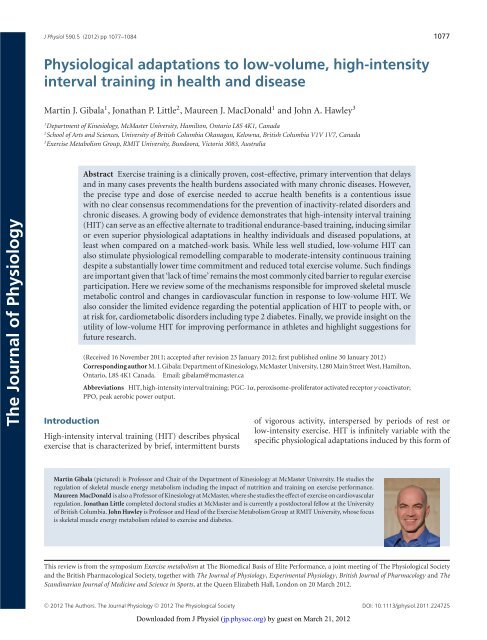

![NASTAVNI_PLAN_I_PROGRAM-_integrirani_studij [2,09 MiB]](https://img.yumpu.com/23830973/1/184x260/nastavni-plan-i-program-integrirani-studij-209-mib.jpg?quality=85)
